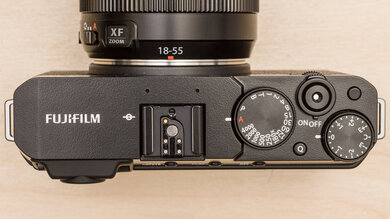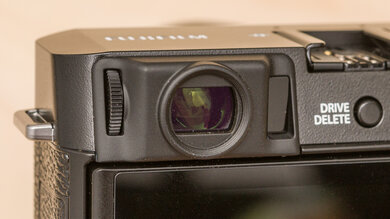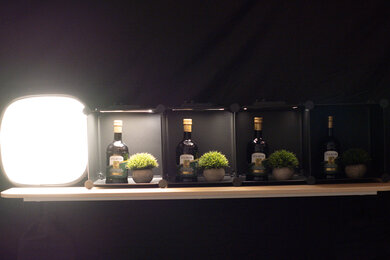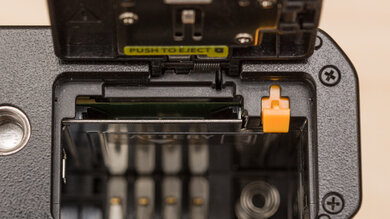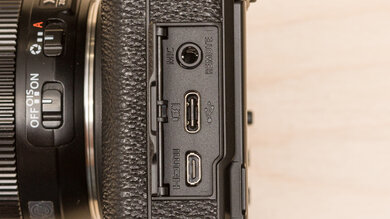The Fujifilm X-E4 is an APS-C mirrorless camera. It's very portable, which makes it easy to travel with, and it feels impressively well-built. Image quality is great out of the box, with minimal noise and very little degradation of sharpness, even when shooting at moderately high ISO levels. It can shoot 4k video at up to 30 fps without a crop, and video quality is good whether you're shooting in 4k or FHD. However, its minimalistic design can make accessing some core camera functions a little difficult and make it a little uncomfortable to hold for extended periods.
Our Verdict
The Fujifilm X-E4 is good for travel photography. Image quality is impressive, with sharp images and great dynamic range, though its noise handling capability is only decent in low light. The camera is very compact and lightweight, making it easy to slip in and out of a pocket or carrying pouch. If you're shooting in JPEG, you can choose between 18 different film simulation modes for a bit of added flair. Unfortunately, the camera's autofocus system can struggle to track both subjects' faces as well as moving objects. Also, its minimalistic design can make it uncomfortable to use for long shooting sessions, with no actual handgrip and few dedicated controls for adjusting exposure parameters on the fly.
-
Compact, lightweight design.
-
Great build quality.
-
Impressive image quality.
-
Middling autofocus performance.
-
Uncomfortable ergonomics.
-
Not water-resistant.
The Fujifilm X-E4 is very good for landscape photography. It offers excellent image quality out of the box and has an impressively wide dynamic range to preserve more detail in high-contrast lighting conditions. Its compact, sturdy-feeling body makes it easy to bring with you to any remote shooting location. Its touchscreen display is also bright enough to be easily seen even under direct sunlight. It isn't rated as being weather-sealed. In addition, its minimalistic design, with no dedicated handgrip, can make it uncomfortable to use for long shooting sessions, especially when using heavier lenses.
-
Compact, lightweight design.
-
Great build quality.
-
Impressive image quality.
-
Sharp, bright flipping and tilting screen.
-
Middling autofocus performance.
-
Uncomfortable ergonomics.
-
Not water-resistant.
The Fujifilm X-E4 is decent for sports and wildlife photography. You can use its electronic shutter to increase its maximum continuous shooting speed up to 30 fps, which should help capture clear shots of very fast-moving subjects, though it's worth noting that using that feature incurs a crop and is more likely to introduce rolling shutter artifacts. Image quality is great, and the camera itself feels impressively sturdy. Unfortunately, its highly compact design can make it somewhat uncomfortable to use, and you may find it unwieldy in conjunction with a heavy telephoto lens. It also lacks any onboard image stabilization feature, making it challenging to capture clear images at extended focal lengths. Its autofocus system can also have a hard time tracking moving subjects.
-
Great build quality.
-
Impressive image quality.
-
Fast maximum shooting speed.
-
Middling autofocus performance.
-
No in-body or digital image stabilization features.
-
Uncomfortable ergonomics.
The Fujifilm X-E4 has good RAW image quality. Its sensor captures a good level of fine detail, so images look fairly crisp even when you punch in. Its sensor also has an impressive amount of dynamic range, so it can capture a wide array of detail in high-contrast scenes. However, its noise handling is just decent, though noise can be mitigated in low light by shooting at slower shutter speeds or opening up your aperture.
-
Great dynamic range.
-
High resolution.
-
Noise handling is just decent.
The Fujifilm X-E4 is okay for vlogging. Its screen can tilt and flips up for selfies, and its lightweight design makes it highly portable. Video quality is also good whether you're shooting in 4k or FHD, and the camera's autofocus system does a superb job of tracking subjects' faces while recording video. It also features a wide complement of inputs and outputs, which is good if you plan on attaching an external recorder or an auxiliary microphone. Unfortunately, it lacks in-body image stabilization, meaning that you may observe some level of camera shake while shooting handheld, depending on whether or not your lens has an optical stabilization feature. It also can overheat during extended recording sessions, especially when shooting in 4k, though the severity of this risk can vary depending on real-world conditions.
-
Compact, lightweight design.
-
Good video quality in FHD and 4k.
-
Wide selection of inputs and outputs.
-
Sharp, bright flipping and tilting screen.
-
No in-body or digital image stabilization features.
-
Can overheat easily.
-
30-minute recording time limit.
The Fujifilm X-E4 is decent for studio video. Video quality in FHD and 4k is good overall, though you may notice a bit of noise when shooting in darker environments. Its autofocus system delivers superb performance in FHD and does a great job of tracking subjects when shooting in 4k. This camera also supports Log recording, yielding a wider dynamic range and allowing for in-depth color grading while editing. If you plan on shooting video with an external recorder, it's capable of outputting 10-bit 4:2:2 color video through its HDMI port, too. It features a wide variety of inputs and outputs, including a microphone jack and an analog to USB-C adapter if you plan on using a pair of headphones to monitor audio levels. Unfortunately, your recording may be interrupted by overheat warnings, though the frequency of these interruptions can vary in real-world conditions.
-
Good video quality in FHD and 4k.
-
Wide selection of inputs and outputs.
-
Capable of outputting 10-bit 4:2:2 video over HDMI.
-
Can overheat easily.
-
Internal recording limited to 8-bit.
-
30-minute recording time limit.
The Fujifilm X-E4 isn't for action video. While compact, lightweight, and well-built, it isn't meant to be attached to a chest or helmet rig. The manufacturer hasn't rated it as being weather-sealed. It also lacks in-body or digital image stabilization, so you may notice some level of camera shake in handheld videos, depending on whether the lens you use has an optical stabilization feature. Still, this camera does have a dedicated slow-motion shooting mode in FHD and can shoot 4k video without a crop, though it's limited to a maximum frame rate of 30 fps in that resolution.
-
Compact, lightweight design.
-
Great build quality.
-
Good video quality in FHD and 4k.
-
No in-body or digital image stabilization features.
-
Not water-resistant.
-
Can overheat easily.
- 7.5 Travel Photography
- 7.9 Landscape Photography
- 7.2 Sport & Wildlife Photography
- 7.9 Raw Photo Performance
- 7.3 Vlogging
- 7.4 Studio Video
- 5.9 Action Video
Changelog
- Updated Jan 29, 2024: Added text to the 'Raw Photo Performance' verdict box and updated existing verdict boxes for clarity and accuracy.
- Updated Jan 29, 2024: Converted to Test Bench 0.12.1.
- Updated Aug 14, 2023: We've updated the sensor type to 'BSI CMOS' to reflect the sensor's back-illuminated design. We previously only noted that it was a 'CMOS' sensor.
- Updated Jun 06, 2023: We've updated the 'App Name' in the 'Menu System' section of the review to reflect this camera's compatibility with Fujifilm's new XApp.
- Updated Apr 24, 2023: Converted to Test Bench 0.12.
Check Price
Differences Between Sizes And Variants
The Fujifilm X-E4 is available in two different color variants: 'Black' and 'Silver'. We purchased the 'Black' variant in conjunction with the FUJINON XF 18-55mm F2.8-4 R OIS lens, and you can see its label here. You can buy the camera in a bundle with the FUJINON XF 27 mm f/2.8 R WR lens and is fully compatible with any other X-Mount lenses.
Let us know in the discussions if you come across another variant of this camera, and we'll update our review.
Popular Cameras Comparisons
The Fujifilm X-E4 is almost like an interchangeable-lens version of the Fujifilm X100V, so one may suit you better than the other. Discounting the lens, the two cameras are similar in size and design, and they both use the same 26MP X-Trans 4 sensor, resulting in similar overall image quality. The X100V has a better hybrid electronic/optical viewfinder and feels a bit more comfortable in the hand thanks to its small handgrip and more physical controls and dials. It isn't as well suited for video work, though, due to poor heat management and a much shorter recording time limit than the X-E4.
The Fujifilm X-E4 and the Fujifilm X-T30 II are both great mid-range options in Fujifilm's lineup. They share the same sensor, so the image and video quality is comparable. The biggest difference between them is their design; the X-E4 is more portable, with an offset viewfinder and no handgrip, while the X-T30 II includes more physical controls and a small handgrip, offering slightly better ergonomics.
Test Results
- Mainly made of plastic, but top plate is made of magnesium alloy
- Plastic used on the outside of the camera has a pebbled texture, but it isn't rubberized
- Dials feel sturdy and feel nice to the touch
- "Drive/delete", "Play", and "AEL/AFL" buttons are small, but are raised from the body and offer good physical feedback
- "Menu/OK", "Disp/Back", "Q", and "Function" buttons are small, lie flush against the body, and offer almost no physical feedback, making it hard to tell if you've made an input
- Solid-feeling screen and flash mechanisms
- Battery and SD card compartment covered by a locking hinged door
- Input and output compartment is covered by a solid hinged door
- Plastic hinged door to the battery and SD card compartment is wobbly, though this could be unique to our test unit
- Fujifilm X-E4 camera body
- Sensor cap
- 1x NP-W126S battery
- Shoulder strap
- USB-A to USB-C cable
- USB-C to analog audio adapter
- Basic manual
Note: This camera came bundled with the FUJINON XF 27 mm f/2.8 R WR lens, but we didn't test the camera with it, and therefore it wasn't included in the 'In The Box' picture.
- Lack of a handgrip and non-rubberized plastic body doesn't allow for a secure grip on the body and makes it uncomfortable to hold for long periods
- You can purchase the MHG-XE4 accessory grip or the TR-XE4 thumb rest at an additional cost
- Minimalistic control scheme makes accessing some functions a little tricky
- Unlike the Fujifilm X100V, this camera lacks a dedicated ISO dial, so you need to navigate the menu to change this parameter
- No dedicated video recording button
- Changing shutter speed is easy thanks to the dedicated dial, but you might find it cumbersome to change aperture if you don't use a lens with a dedicated aperture ring
- You can swipe on the touchscreen to access some core functions, and you can extensively customize what these gestures do.
- Small viewfinder can be uncomfortable to press your eye against for long shooting sessions
- Q Menu button is small and is located on top of the camera
- Memory card can't be changed while the camera is mounted on a tripod
- Built-in guide mode expands on some core features, but it's quite limited overall, with some functions not being explained at all
- You can customize the function of the Q, AEL, and fn buttons as well as the swipe gestures for the touchscreen
- Menu can be navigated quickly with the thumb control stick
- Q Menu lets you access commonly used parameters and can be customized to add or remove certain functions
- Some brand-specific terminology for certain features. For instance, what's commonly referred to as the metering mode is called 'Photometry'
Note: Using the electronic shutter allows you to fire at up to 30 fps, but doing so incurs a crop on your image. Also, shooting at 20 fps with the electronic shutter lowers the JPEG buffer size to 59 shots and increases the buffer clearing time from '0s' to '8s' compared to the results shown, which we achieved with the mechanical shutter.
Note: This camera's image stabilization performance was also evaluated with the FUJINON XF 27 mm f/2.8 R WR lens. The result for the 'Minimum Shutter Speed Achieved' test is 1/50s.
Note: This camera is capable of recording high-speed FHD video in 120 fps and 240 fps, but it only allows for playback of this footage in 10x, 8x, 4x, or 2x slow-motion speed. It can't actually playback this footage at normal speed. Audio isn't recorded in this shooting mode either. This feature is available in the 'Full HD High Speed Rec' menu. Enabling this feature also incurs a crop.
Note: When recording at 60 fps, 30 fps, or 24 fps, the camera has a recording time limit of approximately 30 minutes. When recording at 120 fps, this drops to six minutes. While shooting at 240 fps, you can only record continuously for three minutes.




